necropsy
Healthy gray whale killed by ship propeller
Jan/25/15 05:07 AM
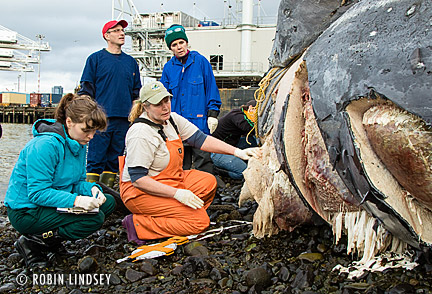
Yesterday, a necropsy exam was performed by biologists from NOAA’s marine mammal stranding network, led by Cascadia Research and Washington Department of Fish and Wildlife with support from interns, marine mammal vets and volunteers from Sno-King MMSN and Seal Sitters MMSN.
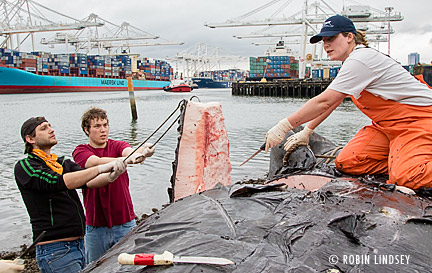
A thick, oily layer of blubber (right) and food in the intestines indicated the two - three year old whale was in excellent health. It is a bit unusual for a gray whale to be inside Puget Sound in January. The gray was assumed headed south to Baja California’s warm winter breeding grounds after a successful season feeding in the rich waters of Alaska’s Bering and Russia’s southern Chukchi seas. Watch a video here that shows typical feeding behavior of a gray whale, scooping up large mouthfuls of ocean sediment and straining invertebrates through a comb-like filter of baleen. In the spring, on their 10,000 mile roundtrip migration back north, it is common for gray whales to venture into inland waters to feast on ghost shrimp around Whidbey Island.
Washington State averages about a half-dozen gray whale strandings each year. Thanks to the Port of Seattle for providing a secure location to perform the examination. The whale will be sunk to decompose and nourish the marine ecosystem.
Read Seal Sitters “Gray Whale Facts” here.
Harbor porpoise dies off Alki
Mar/18/12 07:52 AM
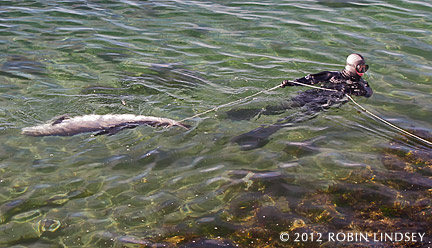
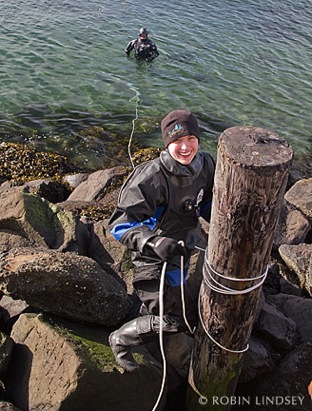
While the team from Cascadia Research (primary response team for cetaceans in South Puget Sound and the outer coast) and WDFW-MMI weighed the options with impending tide levels, it was determined the animal needed to be moved to an area with easier access than the steep rocks below the sea wall. Our investigator scaled the wall and towed the porpoise in the surf approximately 1/3 mile down to the sandy beach at Alki. Three volunteers assisted her in getting the estimated 150 lb. porpoise high up onto the beach, secured behind a large log overnight. Volunteers Christine and Raiana measured the porpoise at 5’8” while our responders documented the general condition with photographs. There were no obvious wounds evident in our preliminary examination of the porpoise.
To learn about harbor porpoise, click here.
UPDATE: 3/18 afternoon
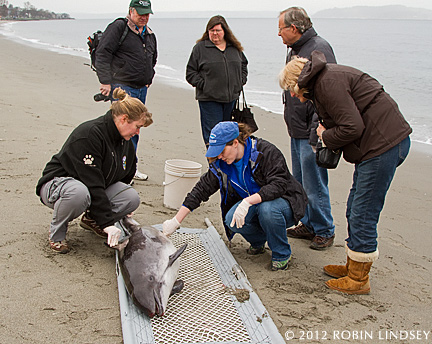
NECROPSY RESULTS UPDATE: 3/18 10:31 pm
Just in - The preliminary results of the necropsy reveal that the 3-5 year old female harbor porpoise suffered from a severe lung infection, with approximately 90% of each lung affected with pneumonia and markedly enlarged lymph nodes in the chest. The infection appeared to be systemic - not only causing damage to the chest , but had spread to the abdomen as well. Tissue samples will be sent to multiple laboratories to determine cause of the infection (fungal, bacterial, viral, parasitic or a combination of organisms). Final results can take a couple of months.
Stranding network examines dead Southern Resident orca
Feb/13/12 09:24 PM
A team of biologists and volunteers from NOAA’s NW Marine Mammal Stranding Network, including Seal Sitters, conducted a necropsy on a juvenile orca from the Southern Resident “L” pod on the Long Beach Peninsula yesterday. While the majority of network responses are to seal pups and other pinnipeds, every year whales of all species strand along the shores of Washington State. This is the second killer whale stranding in the past three months.
The full report prepared by Jessie Huggins (Cascadia Research - photo left), Deb Duffield (Portland State University) and Dyanna Lambourn (Washington Department of Fish and Wildlife - photo right) follows:
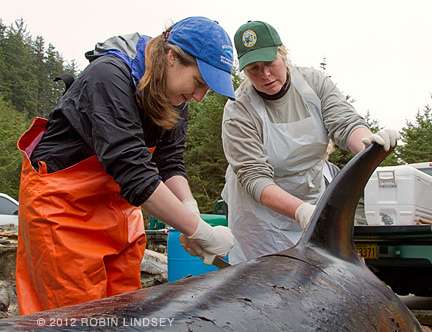 A detailed external and internal examination was conducted on February 12, 2012 of a stranded killer whale that washed up just north of Long Beach, Washington on the morning of February 11. The 12’3” (3.75m) juvenile female was taken to a secure location for a full necropsy by biologists and volunteers from a number of organizations that are part of the Northwest Marine Mammal Stranding Network, including Portland State University, Cascadia Research, Washington Department of Fish and Wildlife Marine Mammal Investigations, Seaside Aquarium, Seattle Seal Sitters, the Makah Tribe, and NOAA Fisheries.
A detailed external and internal examination was conducted on February 12, 2012 of a stranded killer whale that washed up just north of Long Beach, Washington on the morning of February 11. The 12’3” (3.75m) juvenile female was taken to a secure location for a full necropsy by biologists and volunteers from a number of organizations that are part of the Northwest Marine Mammal Stranding Network, including Portland State University, Cascadia Research, Washington Department of Fish and Wildlife Marine Mammal Investigations, Seaside Aquarium, Seattle Seal Sitters, the Makah Tribe, and NOAA Fisheries.
Photographs of the dorsal fin and saddle patch were matched to catalogs of known killer whales by biologists from National Marine Fisheries Service and the Center for Whale Research. She has been identified as L112, a member of the Southern Resident L Pod. Born in 2009, she was the second surviving calf of L86.
The whale was moderately decomposed and in good overall body condition. Internal exam revealed significant trauma around the head, chest and right side; at this point the cause of these injuries is unknown. There have been reports of sonar activity in the Strait of Juan de Fuca in the past week and a half and members of K and L pod were reportedly in the area at the time as well. We do not know if this whale was among those in the area but the possibility is under consideration. The skeleton will be cleaned and closely evaluated by Portland State University for signs of fracture and the head has been retained intact for biological scanning. Additionally, samples were taken for a variety of analyses: genetics, contaminants, bacteriology, virology, food habits, biotoxins and histopathology. The processing of these tissue samples could take several weeks or months and will hopefully provide insight into the origin of the traumatic injuries or other factors that may have contributed to the death of this whale.
This is the second killer whale to strand on the Long Beach peninsula in the past three months. The first case was a killer whale calf that stranded north of the Seaview Beach approach on November 14, 2011. The carcass was promptly collected and transported to Portland State University, where thorough necropsy was conducted by Portland State University, Washington Department of Fish and Wildlife Marine Mammal Investigations, Cascadia Research, NOAA, and Dr. Stephen Raverty. A genetics sample was taken and the female calf has been confirmed as an eastern North Pacific offshore. A congenital defect was determined to be the cause of death in this case.
More information on killer whales can be found on the Cascadia Research killer whale page, at the Center for Whale Research, Fisheries and Oceans Canada, and the Northwest Fisheries Science Center websites.
View a condensed photo gallery of the necropsy here. Warning: necropsies are graphic events and while every effort has been made to be discreet in photo selection, some may be disturbing and are not recommended for children.
The full report prepared by Jessie Huggins (Cascadia Research - photo left), Deb Duffield (Portland State University) and Dyanna Lambourn (Washington Department of Fish and Wildlife - photo right) follows:

Photographs of the dorsal fin and saddle patch were matched to catalogs of known killer whales by biologists from National Marine Fisheries Service and the Center for Whale Research. She has been identified as L112, a member of the Southern Resident L Pod. Born in 2009, she was the second surviving calf of L86.
The whale was moderately decomposed and in good overall body condition. Internal exam revealed significant trauma around the head, chest and right side; at this point the cause of these injuries is unknown. There have been reports of sonar activity in the Strait of Juan de Fuca in the past week and a half and members of K and L pod were reportedly in the area at the time as well. We do not know if this whale was among those in the area but the possibility is under consideration. The skeleton will be cleaned and closely evaluated by Portland State University for signs of fracture and the head has been retained intact for biological scanning. Additionally, samples were taken for a variety of analyses: genetics, contaminants, bacteriology, virology, food habits, biotoxins and histopathology. The processing of these tissue samples could take several weeks or months and will hopefully provide insight into the origin of the traumatic injuries or other factors that may have contributed to the death of this whale.
This is the second killer whale to strand on the Long Beach peninsula in the past three months. The first case was a killer whale calf that stranded north of the Seaview Beach approach on November 14, 2011. The carcass was promptly collected and transported to Portland State University, where thorough necropsy was conducted by Portland State University, Washington Department of Fish and Wildlife Marine Mammal Investigations, Cascadia Research, NOAA, and Dr. Stephen Raverty. A genetics sample was taken and the female calf has been confirmed as an eastern North Pacific offshore. A congenital defect was determined to be the cause of death in this case.
More information on killer whales can be found on the Cascadia Research killer whale page, at the Center for Whale Research, Fisheries and Oceans Canada, and the Northwest Fisheries Science Center websites.
View a condensed photo gallery of the necropsy here. Warning: necropsies are graphic events and while every effort has been made to be discreet in photo selection, some may be disturbing and are not recommended for children.
Sea lion investigation update
Jan/28/12 12:43 PM
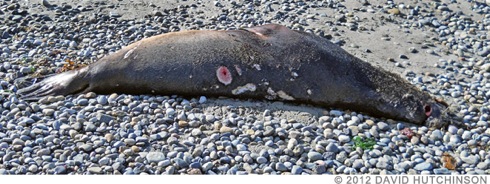
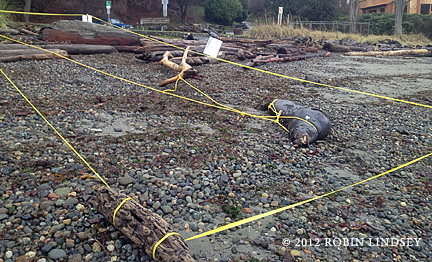
Please check back for continued updates on this on-going investigation. You can help protect marine mammals by being vigilant both from shore and by boat, watching for any harassment or violence and reporting to NOAA’s Office for Law Enforcement.
Lincoln Park sea lion necropsy results revealed
Jan/26/12 09:39 PM
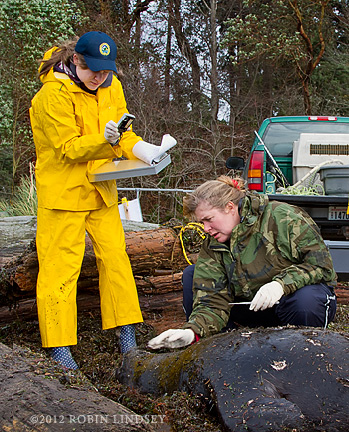
The moderate to advanced decomposed animal had been scavenged by birds and other creatures and had a shark bite wound. Muscle and tissue were closely examined for trauma and hemorrhage; evidence of a “penetrating” wound, suspected to be that of a bullet, was found deep in the tissue and tracked back to the entrance wound. Bullets create small entry holes that are often difficult to detect on the exterior. The head and lungs were removed for further examination and radiographs. That afternoon, a bullet was removed from the left lung lobe. Additionally of note, the intestines were twisted and will be examined - causes can include fishing lures and line, plastics, tumors or possible trauma from the wound. Organ tissue samples were taken for histopaths. WDFW intern and new Seal Sitters volunteer, Allison Reeder (left in photo), assists Dyanna with photo documentation.
NOAA Office for Law Enforcement has been notified and evidence and information will be turned over for investigation.







